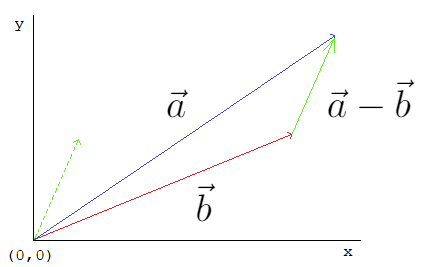I had this one on my to-do list for a long time, I thought it was time to do it! If you didn’t guess already, this article will cover the :ToWorldSpace() and :ToObjectSpace() methods of CFrame, along with other info. The article does expect from you a decent knowledge of vectors, and simple CFrame operations.
Understanding from a Vector point of view first
I think once you get what’s going on from a Vector level of complexity, understanding the CFrame level of complexity would be easy. Let’s say you have vectors a and b.
Adding a and b is the same as putting the tail of a on the head of b, while a keeps its direction of course, and wherever the head of a lands is the new vector.
Now, you might already know this, so why am I telling you this? Well, this is a quite useful thing to know, with it you can have a better understanding of when to use vector addition.
For example, let’s suppose you raycasted a ray into a part and you used the Normal given by RaycastResults. (If you don’t know about raycasting nor normals, pretty much a surface normal is the direction, which is also a vector, that describes a face/surface of a part.)

But wait! All vectors are supposed to start at the origin of the world, in other words (0,0,0). That vector shouldn’t start from the face, it should start from 0,0,0, keep the same direction and same length.

If you were to print the vector, you can see that the coordinates are small (it is a unit vector after all but let’s not talk about that), so it wouldn’t really make much sense for it to be there. You can place a part and set its position to the vector and you can see the result.
What would I need to do if I wanted to get the vector we expected? Well, take a look at this

Doesn’t this just look like how vector additions works in the second picture in this article? Notice how I moved the normal to start from the green vector, where it visually starts from, while the real one is at 0,0,0. We put the normal’s tail on the head of part.Position - Vector3.new(part.Size.Z/2, 0, 0), the result: the vector we expected, x! This is the same as:
x = normal + (part.Position - Vector3.new(part.Size.Z/2, 0, 0))
Let’s say we had that x vector, and the part.Position - Vector3.new(part.Size.Z/2, 0, 0) vector, and we want to find the normal. It’s possible! It’s actually just
normal = x - (part.Position - Vector3.new(part.Size.Z/2, 0, 0))
And let me actually visualize how vector subtraction works

Summary

Pretty cool right?
Alright, what If I were to tell you that, when raycasting and getting the normal, the normal is given to you in the object space of part.Position - Vector3.new(part.Size.Z/2, 0, 0),
and that, doing normal + part.Position - Vector3.new(part.Size.Z/2, 0, 0) is converting the normal to world space.
Another good example, which I mentioned in this article, is the mouse. The mouse’s origin is actually the camera’s position. If I wanted to get the actual mouse position


